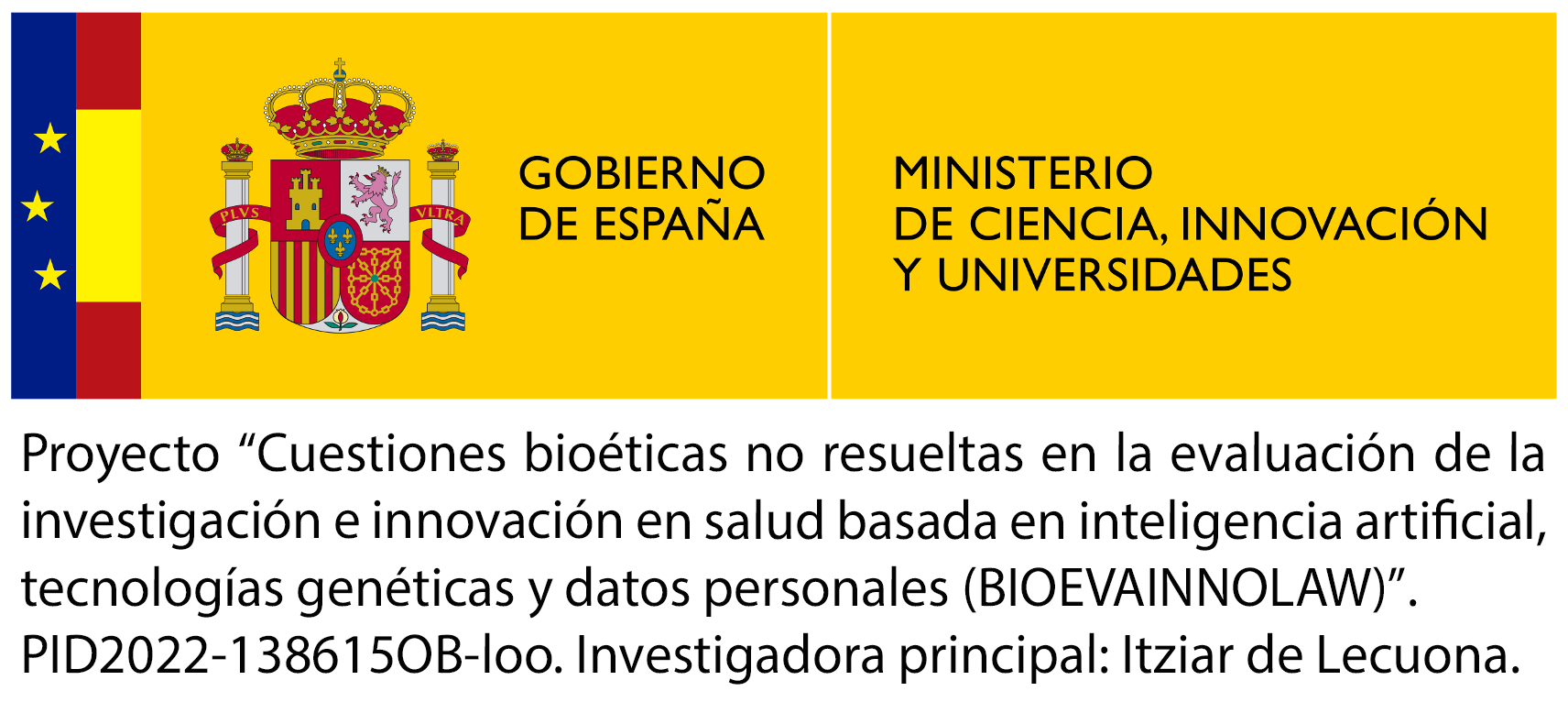Interrogantes y retos actuales de la edición genética
DOI:
https://doi.org/10.1344/rbd2019.0.28551Palabras clave:
edición génica, modificación genética, células germinales, terapia génica, impulso génicoResumen
La tecnología de la edición génica por CRISPR ha revolucionado tanto la investigación en biotecnología como en biomedicina. Esta técnica tan poderosa y versátil permite editar los genes de cualquier especie a la carta. A pesar de su potencia y efectividad, quedan muchas cuestiones para resolver y controlar su resultado final, particularmente en las aplicaciones sobre el genoma de los seres humanos. En este artículo se plantean tanto los puntos fuertes y puntos débiles de la técnica, como otras cuestiones abiertas sobre la edición génica, sobre si debe dirigirse a la terapia o a la mejora, si la modificación debe constreñirse a células somáticas o también a editar a embriones, modificando el genoma de los seres humanos del futuro.Citas
1 MOJICA, F.J.M.; MONTOLIU, L. On the Origin of CRISPR-Cas Technology: From Prokaryotes to Mammals. Trends in Microbiology 24:811-820 (2016).
2WANG, H.; LA RUSSA,M.; LI, Q.S. CRISPR/Cas9 in Genome Editing and Beyond". Annual Reviews in Biochemistry 85:227-64 (2016).
3 REARDON, S. CRISPR creates wave of exotic model organisms. Nature 568: 441-442 (2019).
4 THOMAS et al. Collateral damage and CRISPR genome editing. PLOS Genetics 2019 (https://doi.org/10.1371/journal.pgen.1007994)
5 DOUDNA, J.; CHARPENTIER, E. The new frontier of genome engineering with CRISPR-Cas9. Science 346:1077 (2014).
6 FDA Statement 2018 (https://www.fda.gov/news-events/press-announcements/statement-fda-commissioner-scott-gottlieb-md-and-deputy-commissioner-anna-abram-fdas-new-plan)
7 European Commission Scientific Advisors Statement 2018 (https://ec.europa.eu/info/news/commissions-chief-scientific-advisors-publish-statement-regulation-gene-editing-2018-nov-13_en)
8 CRISPO et al. Efficient generation of myostatin knock-out sheep using CRISPR-Cas9 technology and microinjection in zygotes". PLoS One 10:e0136690 (2015).
9 PARTHASARATHY, S. Use the patent system to regulate gene editing. Nature 562: 486-488 (2018).
10 ESVELT et al. Concerning RNA-guided gene drives for the alteration of wild populations. eLife 3:e03401 (2014).
11 LUNSHOF, J. Regulate gene editing in wild animals. Nature 521:127 (2015).
12 MONTOLIU, L. CRISPR: la edición genética aún no está preparada para tratar a pacientes (2018) (https://theconversation.com/crispr-la-edicion-genetica-aun-no-esta-preparada-para-tratar-a-pacientes-107148).
13 ROSENBAUM, L. The Future of Gene Editing –Toward Scientific and Social Consensus. New England Journal of Medicine (2019) DOI:10.1056/NEJMms1817082.
14 CHECK HAYDEN, E. Tomorrow's children. Nature 530: 402-405 (2019).
15 LESSARD et al. Human genetic variation alters CRISPR-Cas9 on- and off-targeting specificity at therapeutically implicated loci. Proceedings of the National Academy of Sciences (USA) 114:E11257-E11266 (2017).
16 WU, Y. et al. Highly efficient therapeutic gene editing of human hematopoietic stem cells. Nature Medicine (2019) (https://doi.org/10.1038/s41591-019-0401-y)y
17 THOMSON REUTERS NEWS (https://www.reuters.com/article/us-novartis-luxturna/novartiss-pricing-might-be-tested-with-costly-eye-therapy-idUSKCN1NS0FM)
18 GASKELL G. et al. Public views on gene editing and its uses. Nature Biotechnology 35:1021–102 (2017).
19 LANDER, E.S. Brave New Genome. New England Journal of Medicine 373:5-7 (2015).
20 STERCKX, S. et al. “I prefer a child with …”: designer babies, another controversial patent in the arena of direct-to-consumer genomics. Genetics in Medicine 15:923-924 (2013).
21 LEDFORD, H. Biohackers gear up for genome editing. Nature 524:398-399 (2015).
22 SMALLEY, E. FDA warns public of dangers of DIY gene therapy. Nature Biotechnology 36:119–120 (2018).
23 NORMILE, D. Shock greets claim of CRISPR-edited babies. Science 362:978-979 (2018).
24 ALTA CHARO, R. Rogues and Regulation of Germline Editing. New England Journal of Medicine (2019). DOI: 10.1056/NEJMms1817528
25 CYRANOSKI, D. CRISPR-baby scientist fails to satisfy his critics. Nature 564:13-14 (2018).
26 CYRANOSKI, D. What's next for CRISPR babies. Nature 566:440-442 (2019).
27 NORMILE, D. China sprints ahead in CRISPR therapy race. Science 358:20-21 (2017).
28 LANPHIER, E. et al. Don't edit the human germ line. Nature 519:410-411 (2015).
29 LANDER, E.S. et al. Adopt a moratorium on heritable genome editing. Nature 567:165-168 (2019).
30 SANTALÓ, J. y CASADO, M (coords). Document sobre bioètica i edició genòmica en humans. (2016). Observatori de Bioètica i Dret Universitat de Barcelona
31 de LECUONA I. et al. Gene Editing in Humans: Towards a Global and Inclusive Debate for Responsible Research.Yale Journal of Biology and Medicine 90:673-681 (2017).
32 HOWARD, H.C. et al. One small edit for humans, one giant edit for humankind? Points and questions to consider for a responsible way forward for gene editing in humans. European Journal of Human Genetics 26:1-11 (2017).
33 MONTOLIU, L. et al. ARRIGE Arrives: Toward the Responsible Use of Genome Editing. The CRISPR Journal 1: 128-129 (2018).
34 NUFFIELD COUNCIL OF BIOETHICS. Genome editing and human reproduction. (2018). ISBN: 978-1-904384-34-2.
35 KÖNIG, H. The illusion of control in germline-engineering policy. Nature Biotechnology 35:502-506 (2017).
36 SAVULESCU, J. Genetic interventions and the ethics of enhancement of human beings. In: STEINBOCK, B, ed. The Oxford Handbook of Bioethics. Oxford: Oxford University Press, p. 516-535 (2009).
37 THE NICHE (2015). (https://ipscell.com/2015/03/georgechurchinterview/)
38 THE LANCET (Editorial). Genome editing: science, ethics, and public engagement". The Lancet 390:625 (2017).
Descargas
Publicado
Cómo citar
Número
Sección
Licencia
 Las/os autoras/es conservan los derechos de autoría de los artículos y autorizan a la Universitat de Barcelona a publicarlos en su Revista de Bioética y Derecho y a incluirlos en los servicios de indexación y abstracts, bases de datos académicas y repositorios en los que participa la revista.
Las/os autoras/es conservan los derechos de autoría de los artículos y autorizan a la Universitat de Barcelona a publicarlos en su Revista de Bioética y Derecho y a incluirlos en los servicios de indexación y abstracts, bases de datos académicas y repositorios en los que participa la revista.
Los trabajos publicados en la Revista de Bioética y Derecho están bajo la licencia Creative Commons Reconocimiento - NoComercial - SinObraDerivada 4.0 Internacional (by-nc-nd 4.0), que permite compartir la obra con terceros, siempre que éstos reconozcan su autoría, su publicación inicial en esta revista y las condiciones de la licencia. No se permite un uso comercial de la obra original ni la generación de obras derivadas.







